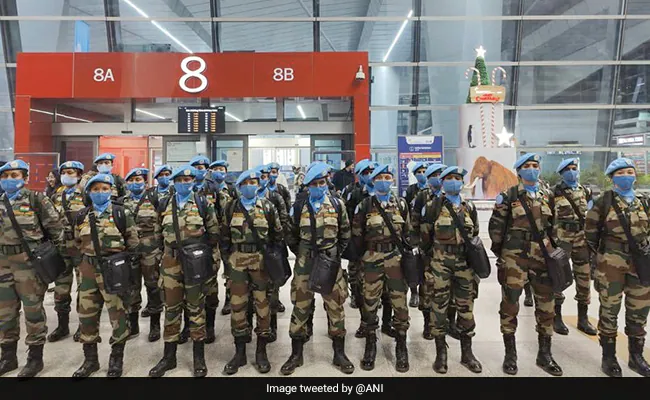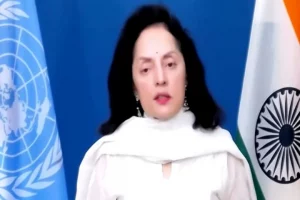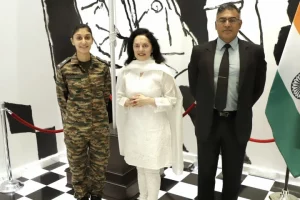On 14th June the United Nations General Assembly adopted by consensus a draft resolution piloted by India to establish a memorial wall in the UN headquarters in New York to honour fallen peacekeepers. The resolution was first mooted in 2015 by India but then went into cold storage. Ambassador Asoke Mukerji was then India’s Permanent Representative to the UN in New York.
Since retired from the Foreign Service, in this interview with Aditi Bhaduri, ambassador Mukerji shares his experience of piloting the proposal for a UN Peacekeepers Memorial Wall, the significance of such a wall, why the UNGA waited for a good eight years to adopt the resolution, and the nature and use of UN peacekeeping operations in general.
Ambassador Mukerji’s distinguished career has included diplomatic assignments to the UK, Kazakhstan, Russian Federation, Geneva, UAE, Uzbekistan, Tajikistan, Turkmenistan, the United States, and the former Yugoslavia.
He currently teaches diplomacy as a Senior Fellow of the Diplo Foundation, is an elected member of the USI Council (2023-25), a Distinguished Fellow of the Vivekananda International Foundation, New Delhi, and a member of the IISS, London.
Excerpts from the interview:
IN: The UNGA has adopted the resolution on constructing a UN Peacekeepers Memorial Wall. India had first proposed this way back in 2015. You were India’s Public Representative to the UN then. Why a Memorial Wall?
AM: A Memorial Wall brings together in one place the names of all the UN troops who have given their lives while deployed on UN peacekeeping operations. This enables a more effective commemoration of the International Day of UN Peacekeepers, which is marked on 29 May every year to coincide with the deployment of the first UN peacekeepers in the UN peacekeeping mission after the Arab-Israel War in 1948. The names on the Wall provide a human dimension to the cold statistics of the numbers of UN troops dying every year. It will allow the countries and families of the deceased troops to feel that their sacrifice is remembered, and treasured, by the international community.
IN: Can you share your experiences of that time. How was the proposal met? Why did it take 8 years for the UNGA to finally adopt it?
AM: The idea came up during the 29 May commemoration in 2014, when the Dag Hammarskjold Medal given by the UN Secretary-General to the troops whose sacrifice was being honoured was received by the Ambassadors or Military Advisors of the countries to which the medal awardee belonged. At that time, the ceremony was held in the dark and dingy confines of the UN Auditorium, and that year it was conducted by the Under Secretary-General for Peacekeeping Operations, not even the UN Secretary-General himself. So, a group of envoys including India began a discussion on how we could make the commemoration more meaningful. That led to the UN Committee on Peacekeeping and the UN General Assembly adopting a decision requiring the UN Secretary-General to personally preside over the 29 May ceremony, and lay a wreath at the monument on the UN Headquarters grounds where the 1988 Nobel Peace Prize given to UN Peacekeepers was celebrated with a small fountain and fibreglass sheets. This became the norm in succeeding years, with the participation of both the UN member-states and UN Secretariat.
The idea of the Memorial Wall came out of this process, and India tabled a proposal to construct a memorial wall on 17 February 2015 at the UN Peacekeeping Committee meeting. This proposal was endorsed by the Committee and subsequently by the UN General Assembly. The reason it was proposed as a Memorial Wall was the example of another evocative military memorial not far from New York – the Vietnam Memorial in Washington DC. Each name of a UN peacekeeper who had died would be inscribed on the Wall, which could be expanded in keeping with events on the ground.
On 28 September 2015, during the Leaders’ Summit on UN Peacekeeping held in New York, Prime Minister Shri Narendra Modi of India supported this idea. He said: “I would like to pay homage to the peacekeepers who have laid down their lives in defending the highest ideals of the United Nations. It would be most fitting if the proposed memorial wall to the fallen peacekeepers is created quickly. India stands ready to contribute, including financially, to this objective.”
It took eight years to have a UN General Assembly resolution tabled to go ahead with the Memorial Wall because the UN Secretariat wanted to go through their internal processes, including having a feasibility study for the proposed Memorial Wall. At the end of the process, 190 member-states in the 193-member UN General Assembly co-sponsored the resolution, making it a record for the cross-cutting appeal of the idea.
IN: India contributes the maximum number of troops to UN Peacekeeping Forces. It is also an area India has been active in since soon after independence. What factors drive India’s decisions regarding this?
AM: India has contributed troops to UN peacekeeping from the Korea War of 1950 onwards. Today India is the single largest contributor, having sent over 275,000 troops to serve under the UN flag in 52 out of the 71 UN peacekeeping missions deployed by the UN Security Council so far. India was the first country in the UN to take the initiative to deploy an all-women peacekeeping unit in Liberia in 2007. When that unit completed its deployment in Liberia in 2016, the President of Liberia Ellen Johnson Sirleaf said: “We see you as family…If I had my will, I would have recommended for another unit of the United Nations Mission in Liberia (UNMIL) to leave, so that the Indian Formed Police Unit (FPU) would continue its stay in the country for the time being”
India’s reasons for contributing troops to UN peacekeeping stem from the fact that India’s armed forces are highly professional, and bring to their deployment their considerable skills in domain awareness and outreach to the affected populations caught in the violence. This has become more prominent as UN peacekeeping operations have been deployed within countries, rather than between countries, as happened in the first few decades of the UN.
A big factor is the ability of Indian troops to be more effective because most of them come from similar rural backgrounds as the communities in the areas they are deployed in. Specific areas where Indian troops provide value added peacekeeping include medical care including for women and children, in setting up temporary schools for displaced children taking shelter in UN protection of civilian camps, providing veterinary care for the livestock of the populations caught up in conflict zones, building destroyed infrastructure like bridges and canals for irrigation, and even in observing how local village-level dispute resolution systems in many countries where UN peacekeeping missions are deployed to defuse disagreements before these spiral and feed into the conflicts ravaging the country. Unfortunately, this role is not recognized by most of the permanent members of the UN Security Council, who decide on the deployment of UN peacekeeping missions.
Since the past few years, India has brought in the use of technology revolving around collection and use of data from the ground where UN peacekeepers are deployed to create real time domain awareness, helping the individual peacekeeper become more effective. The most well-known example of this is the UNITE AWARE platform, unveiled by India in 2021.
An issue that has affected the effectiveness of UN peacekeeping missions is the increased targeting of UN peacekeepers by non-state actors like terrorists. India was among the first countries to call for accountability for such attacks, having experienced the deaths of Indian UN peacekeepers in South Sudan in April 2013. This was followed by affiliates of the al-Qaida in Syria taking UN peacekeepers of UNDOF hostage and releasing them for ransom. The lack of effective counter action by the UNSC has encouraged the spread of such attacks, with Mali which hosts the MINUSMA peacekeeping operation being the most tragic example. India’s initiative taken during its eighth innings as an elected member of the UNSC to seek action by member states against attacks on UN peacekeepers has begun to yield results, which needs to be sustained by the UNSC.
A major contribution to the UN’s three cardinal principles of peacekeeping – impartiality; consent of the parties to the dispute; and use of force in self-defence or defence of the mandate – evolved from the experience on the ground of UN peacekeepers, which got codified through the Military Adviser of the UN Secretary-General. India provided the first such Military Adviser in Major General Indar Jit Rikhye, who served both Secretary-General Dag Hammarskjold and U Thant in the 1960s. He founded the International Peace Academy (today the International Peace Institute) in New York to provide a platform to bring together practitioners in UN peacekeeping to constantly learn from experiences and make peacekeeping effective.
India sees UN peacekeeping as a mechanism available to the UN Security Council to help it discharge its primary responsibility given by the UN Charter for maintaining international peace and security.
IN: Please walk us through the process for the deployment of UN Peacekeeping Forces. How is the decision for deployment of such forces made. Who pays? What are the conditions for such operations, etc.
AM: The UN Secretariat has given details on this. The Charter gives the UN Security Council primary responsibility for the maintenance of international peace and security. In fulfilling this responsibility, the Council may adopt a range of measures, including the establishment of a UN peace operation.
Chapter VI deals with the ‘Pacific Settlement of Disputes‘. UN peace operations have traditionally been associated with Chapter. However, the Security Council need not refer to a specific Chapter of the Charter when passing a resolution authorizing the deployment of a UN peacekeeping operation and has never invoked Chapter VI. Chapter VII contains provisions related to “Action with Respect to the Peace, Breaches of the Peace and Acts of Aggression’. In recent years, the Council has adopted the practice of invoking Chapter VII of the Charter when authorizing the deployment of UN peace operations into volatile post-conflict settings where the State is unable to maintain security and public order. The Security Council’s invocation of Chapter VII in these situations, in addition to denoting the legal basis for its action, can also be seen as a statement of firm political resolve and a means of reminding the parties to a conflict and the wider UN membership of their obligation to give effect to Security Council decisions. Chapter VIII of the Charter provides for the involvement of regional arrangements and agencies in the maintenance of international peace and security provided such activities are consistent with the purposes and principles outlined in Chapter I of the Charter.
UN peace operations are deployed on the basis of mandates from the United Nations Security Council. Over the years, the range of tasks assigned to UN peace operations has expanded significantly in response to shifting patterns of conflict and to best address threats to international peace and security.
Although each UN peace operation is different, there is a considerable degree of consistency in the types of mandated tasks assigned by the Security Council. Depending on their mandate, peace operations may be required to: deploy to prevent the outbreak of conflict or the spill-over of conflict across borders; stabilize conflict situations after a ceasefire, to create an environment for the parties to reach a lasting peace agreement; assist in implementing comprehensive peace agreements; lead states or territories through a transition to stable government, based on democratic principles, good governance and economic development.
Depending on the specific set of challenges, UN peacekeepers are often mandated to play a catalytic role in the following essentially peacebuilding activities: Disarmament, demobilization and reintegration of ex-combatants; mine action; security sector reform and other rule of law-related activities; protection and promotion of human rights; electoral assistance; support for the restoration and extension of State authority; and promotion of social and economic recovery and development.
Security Council mandates also reflect a number of cross-cutting, thematic tasks that are regularly assigned to UN peace operations on the basis of landmark Security Council resolutions on women, peace and security; children and armed conflict; and on the protection of civilians in armed conflict.
As a conflict develops, worsens, or approaches resolution, the UN is frequently involved in a number of consultations to determine the best response by the international community. These consultations would likely involve: all relevant United Nations actors; the potential host government and the parties on the ground; member States, including States that might contribute troops and police to a peace operation; regional and other intergovernmental organizations; other relevant key external partners
During this initial phase the UN Secretary-General may request a strategic assessment to identify all possible options for UN engagement.
As soon as security conditions permit, the Secretariat usually deploys a technical assessment mission to the country or territory where the deployment of a UN peace operation is envisaged. The assessment mission analyses and assesses the overall security, political, military, humanitarian and human rights situation on the ground, and its implications for a possible operation. Based on the findings and recommendations of the assessment mission, the UN Secretary-General will issue a report to the UNSC. This report will present options for the establishment of a peace operation as appropriate including its size and resources. The report will also include the anticipated costs.
If the Security Council determines that deploying a UN peace operation is the most appropriate step to take, it will formally authorize this by adopting a resolution. The resolution sets out the operation’s mandate and size, and details the tasks it will be responsible for performing. The budget and resources are then subject to UN General Assembly approval.
While not normally directly involved in political decisions on establishing or terminating UN peace operations, the General Assembly does play a key role in UN peacekeeping financing.
As all UN Member States share the costs of peacekeeping, the Assembly apportions these expenses based on a special scale of assessments, taking into account the relative economic wealth of Member States, with the permanent members of the Security Council required to pay a larger share because of their special responsibility for the maintenance of international peace and security.
The General Assembly, through its Fifth Committee (Administrative and Budgetary) approves and oversees the peacekeeping budget. This includes how specific field operations are funded and equipped, based on detailed submissions provided to it by the UN Secretary-General.
The Secretary-General normally appoints a Head of Mission (usually a Special Representative) to direct the peacekeeping operation. The Head of Mission reports to the Under-Secretary-General for Peace Operations at the UN Headquarters.
The Secretary-General also appoints a peace operation’s Force Commander and Police Commissioner.
In the meantime, the Head of Mission and the UN Secretariat lead the planning for the political, military, operational and support (i.e., logistics and administration) aspects of the peace operation. The planning phase usually involves the establishment of a Headquarters-based joint working group or integrated mission task force, with participation of all relevant UN departments, funds and programmes.
Deployment of an operation proceeds then as quickly as possible, taking into account the security and political conditions on the ground. It often starts with an advance team to establish mission headquarters and leads to a gradual build-up to encompass all components and regions, as required by the mandate.
The UN has no standing army or police force of its own, and UN member-states are asked to contribute military and police personnel for each operation. Peacekeepers wear their countries’ uniform and are identified as UN peacekeepers only by a UN blue helmet or beret and a badge.
The Secretary-General provides regular reports to the Security Council on the implementation of the mission mandate. The Security Council reviews these reports and briefings, and renews and adjusts the mission mandate, as required, until the missions is completed or closed.
IN: How effective have such Peacekeeping operations been. What role do they play, if any, in peace building?
AM: Unfortunately, over the years, the UNSC has failed in using UN peacekeeping resources effectively, resulting in festering peacekeeping mission such as the MONUSCO in the Democratic Republic of Congo and UNMISS in South Sudan. The failure of the MINUSMA peacekeeping mission in Mali is also due to internal divisions in the UNSC. A particular problem which needs to be addressed is the refusal of the permanent members of the UNSC to hold direct discussions with representatives of troop contributing countries who are not members of the UNSC on deployment of their troops. This is clearly provided for in Article 44 of the UN Charter. The permanent members have diverted this into consultations between the UN Secretariat and the troop contributing countries, which is not the same thing, since the UN Secretariat does not have any power under the UN Charter to take UNSC decisions.


















